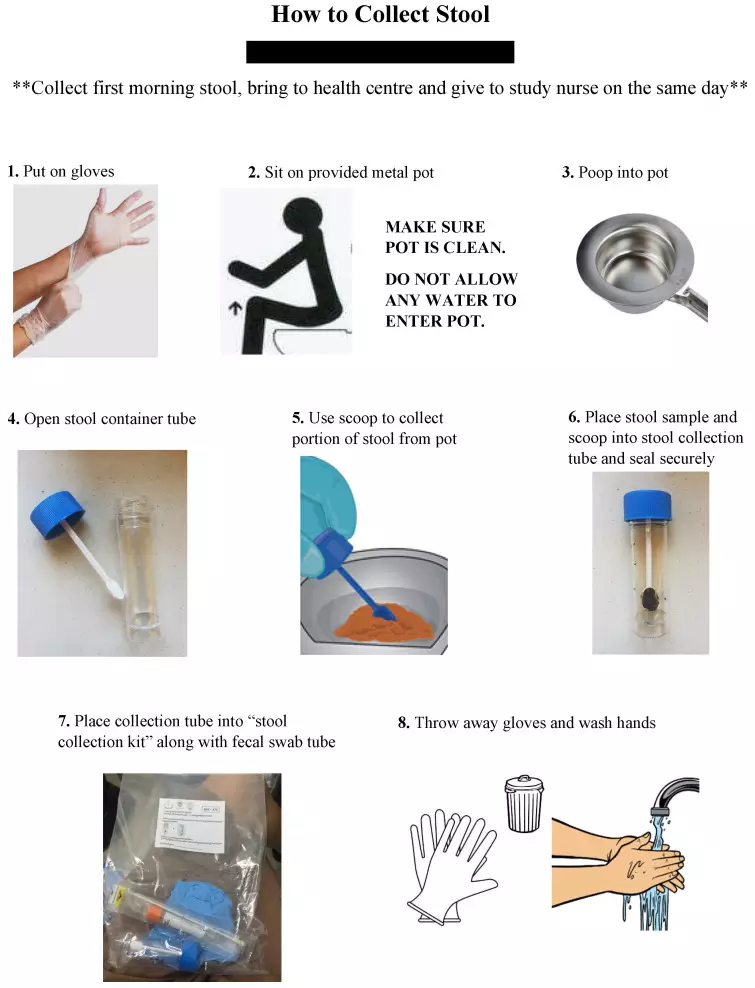
Stool Sample Collection Technique and Instruction
Human faeces are called the stool. Meconium is a newborn first stool. Stool sample collection is a procedure in which stool should be collected in a dry or sterilized wide-mouthed container to identify the pathological condition. Stool sample collection methods require universal precautions. Commonly morning samples should be collected. Patients avoid antibiotic therapy and iron therapy ( orally ) before the sample collection. Stool samples should be away from contact with urine and other body secretions. Instruct patients ono the forceful expulsion of stool to detect the growth of parasites. 50 ml/gm sample should we collect and store at room temperature. The sample sends immediately to the lab after collection.

Stool Sample Collection Technique and Instruction
Stool sample collection Procedure
how to collect stool samples Collect stools first thing in the morning of your visit to your health centre. Before stool sample collection Wear the gloves provided in the stool collection Kit. Sit or sit on top of a given metal vessel. Make sure the pot is not touching the toilet water – make sure no water, other liquids or materials get into the pot. Defecate in the pot. A small amount of stool is fine. Open the stool container tube by opening the blue lid. Use the scoop attached to the Blue Lib to collect a small portion (the size of a cashew) of the stool from the pot. Place the stool specimen and pour it into the stool collection tube and screw the lid on tightly to secure it. Place the tube in a stool collection bag with your personal ID number on it. Dispose of the metal utensil or clean it thoroughly with soap and hot water. Wash hands thoroughly with soap and warm water. Bring the stool sample to the study nurse at the health center the same morning
stool sample collection kit
A stool specimen collection kit is an essential tool used in medical diagnostics to collect and analyze fecal samples for various purposes. Designed to ensure convenience and sanitation, these kits typically include a sterile container or vial, a scoop or spatula for sample collection, and detailed instructions. When a stool sample is required for testing, the kit provides individuals with a simple and efficient method to collect and preserve the sample without contamination. Proper collection and handling of stool specimens are crucial for accurate diagnoses of gastrointestinal disorders, infections, and other medical conditions. The inclusion of a stool sample collection kit in healthcare settings greatly facilitates the process, ensuring reliable and effective analysis while maintaining patient comfort and confidentiality.
Characteristics of Normal Stools
- normal Stools contain 30% water.
- The normal colour of stool is dark brown colour.
- The normal colour of stool is maintained by stercobilin pigment.
- The birth stool is dark green in colour Cald meconium( meconium ).
- The normal odour of stool is – a pungent smell.
- Indole and skatole are substances that produce normal odour.
- In adults, normal stool is well formed and semi solid in consistency.
- Stool pH depends on diet.
- High carbohydrate diets cause acidic pH of stool.
- High protein diets cause alkaline pH of stool.
Characteristics of abnormal stool
- Black tarry colour stool – due to upper GI tract bleeding (melaena)
- Bright red colour stool – due to lower GI tract bleeding (hemorrhoids)
- White colour stool – due to yeast fermentation (candida) and seen in barium swallow.
- Stool with blood and mucous – dysentery.
- Gray/ clay colour of stool is a sign of – obstructive jaundice.
- Green colour stool ( pea soup stool ) is a sign of – typhoid.
- Rice water stool sign of – cholera.
- Ribbon like stool is a sign of – hirschsprung disease.
- Foul smell stool in case of melaena and dysentery.
Nursing role in stool sample collection
- Nurse provided the instruction about the stool collection procedure.
- Provide a wide sterile container.
- Maintain the aseptic sample collection and examination.
- Wear gloves during sample collection and examination.
- After sample collection, send it immediately to the lab.
- If you delay the stool examination, discard the stool in Dustbin.
- Maintain the findings in the documents.
- Hand washing before and after the procedure.
- Maintain the universal precautions.
Key Points
- Newborn first stool is – Meconium
- The normal colour of the stool is – Dark brown colour
- The normal colour of stool is maintained by – Stercobilin pigment
- Normal meconium colour is a – Dark green colour
- The normal odour of stool is – Pungent smell
- Rice water stool is seen in – Cholera
- Ribbon-like stool seen in – Hirschsprung disease
- The gray / clay colour of stool is a sign of – Obstructive jaundice
- Black tarry colour stool sign of – Melana
- Haemorrhoids are a – Bright red stool
- Upper GI tract bleeding causes the – Melaena
- Lower GI tract bleeding causes the – Hemorrhoids
- White colour stool occurs due to – Yeast fermentation



















2 thoughts on “Stool Sample Collection Technique and Instruction”
Nice pdf sir
thanks